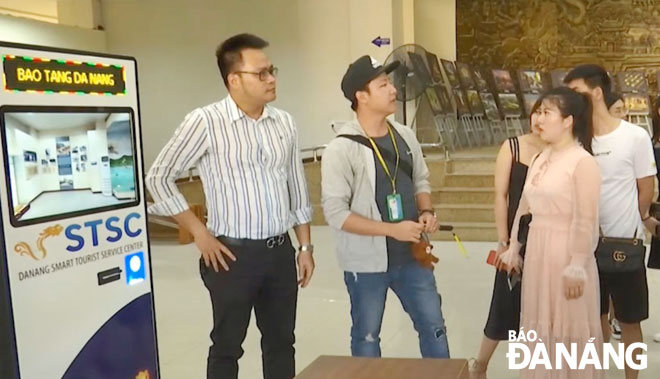Smart travel model application proves effective
After nearly 3 years of conducting research and being put into trial use, a sustainable and smart tourism development model which provides visitor support and management services, called Smart Tourist Service Center (STSC), has received high public appreciation. This is seen as one of Da Nang's best models to help the city boost the uptake of digitalisation in tourism.
 |
| A tour guide introducing experimental tourism products to visitors at the Museum of Da Nang (Picture taken in March 2020). |
The STSC model is the brainchild of a group of researchers from the University of Technology and Education under the University of Da Nang. The intention is to tackle disadvantages of tourism websites and apps in the city, including the lack of vivid interaction and communication with users.
This model is a national-level research project on boosting the application of information technology in Da Nang in order to help the city release its target of developing smart tourism. The research was conducted from October 2017, and totally completed in October 2020.
Dr Tran Hoang Vu, Head of the Electrical - Electronic Engineering Faculty of the University of Technology and Education cum leader of the research, said that the aforementioned model has been operated based on new and modern technologies, including data analysis, context-oriented services, the Internet of Things, and microservice architecture.
This tourism model provides convenient services for tourists, tourism service providers and State management agencies in the tourism industry.
In particular, as for tourists, they can use their cell phones to learn about tourist sites in Da Nang. Especially, they can experience virtual reality technology, and use multi-function travel cards that give them unlimited access to Da Nang's public tourist attractions. Also, they will be provided with useful tourism information through STSC-offered online services.
Meanwhile, tourism service providers will be allowed to sell their tourism products and services on the system, and collect payment through mobile money or other forms of mobile payment. Also, by using this model, they will find it very easy to collect customer feedback in a bid to enhance the quality of their services, and provide new and special products for their customers.
With regard to State management agencies in the tourism industry, the management of visitors and tourism activities across the city will be carried out transparently.
“After nearly 3 years of conducting the research, our group has created products (hardware) such as ‘smart’ travel card (Danang City pass), a Kiosks system promoting multimedia, multi-language tourism, access control system, and a POS device for charging at tourist sites. These products have been trialled at the Museum of Da Nang, the Da Nang Fine Arts Museum, the Museum of Cham Sculpture, and the Gate No 1 and the Am Phu Cave at the Marble Mountains Tourist Area” Mr Vu remarked.
Da Nang Tourism Association Chairman Cao Tri Dung stressed the need for the group of researchers, tourism service providers and State management agencies to work together to bring the scientific research to fruition.
Deputy Director of the municipal Department of Tourism Tan Van Vuong highly lauded the scientific research for its high practicality and feasibility. Mr Van pledged that the Department of Tourism would continue to give active support for the group of researchers in a bid to perfect the model and bring it to fruition soon, thereby significantly contributing to making Da Nang a smarter city in the time to come.
By VAN HOANG – Translated by M.D